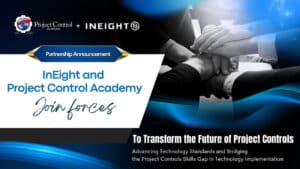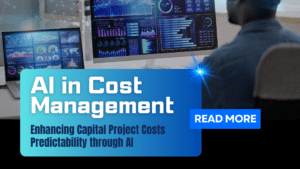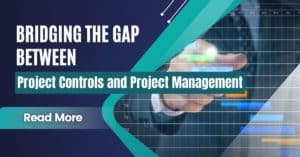Economic evaluation forms the cornerstone of most project authorization determinations. This holds true even for projects driven by necessity rather than profitability, where economics is pivotal in evaluating competing options. The bedrock of this evaluative process is a meticulously prepared, all-encompassing, and dependable cost estimate.
A cost estimate is the foundation for assessing a project’s financial feasibility and offers multifaceted support for project-related verdicts. Its value extends to diverse functions, including conducting comparative analyses of alternative courses of action, facilitating fiscal budgeting, aiding in resource allocation, fostering stakeholder communication, managing risk, and ensuring alignment with strategic goals.
Preparing thorough and reliable project cost estimates is imperative to supporting well-informed decision-making.
In this blog post, I shed light on a simple principle that will guide best practices in cost estimation, ultimately empowering decision-makers with the insights needed to make informed judgments.
Introduction
As the King in Lewis Carroll’s renowned novel Alice in Wonderland states, it is always best to “begin at the beginning.” So, let’s start by defining a cost estimate as “the prediction of the probable costs of a project, for a given and documented scope, to be completed at a defined location and point of time in the future.”[2]
As a prediction of probable costs, we must understand that every will involve assumptions and uncertainty and, therefore, will be associated with some level or degree of error. This uncertainty means that cost estimates will span a range of possible values, each accompanied by a specific likelihood of occurrence.
It’s also crucial to recognize that each estimate is bound by a defined scope. As an element within a cost estimate, the concept of contingency addresses slight variations within this scope but doesn’t cover shifts in the scope itself.
Thus, any cost estimate should not be regarded as a single point number (or value). Every cost estimate represents a range of probable cost outcomes with associated probabilities of occurrence. The accuracy range of an estimate is simply a probabilistic assessment of how far a project’s final actual cost can be expected to vary from a selected value for the estimate. The accuracy range of an estimate will be driven by the risks and uncertainties associated with the estimate. In other words, the only certainty about a single value estimate is that the final project cost will be different!
So, what is the purpose of an estimate, and why is it so important to understand that an estimate should be regarded as a potential range of values?
In response to the initial query regarding the objective of preparing an estimate, I often encounter responses emphasizing aspects like determining project costs, establishing a budget, supporting cost management, or identifying the resources necessary for a project’s execution. While these responses are accurate, they overlook the fundamental rationale behind the creation of project estimates: to facilitate informed decision-making processes. Cost estimates matter!
The significance of cost estimation lies in its support for making critical decisions, such as choosing among various project options, authorizing a project based on its potential for optimal returns on investment, or discontinuing a project if it’s projected not to yield satisfactory returns. This underscores the crucial role of estimates in strategic planning and financial management, ensuring that investments are directed toward ventures that promise the most value.

Regarding the second query above, treating an estimate as a range of values rather than a single-point estimate enhances informed decision-making.
Every unique project (and cost estimate) will have its own set of uncertainties and risks. Providing a range of values for a cost estimate acknowledges this uncertainty, allowing decision-makers to understand the best-case, worst-case, and most likely values reflecting the variability in potential costs. By presenting estimates as ranges, organizations can better prepare for and manage risks. Decision-makers can identify where the greatest uncertainties lie and develop strategies to mitigate these risks, allowing a proactive stance on understanding estimate uncertainty that can lead to more resilient project planning and execution.
A range-bound estimate should allow for a more flexible and dynamic planning and budgeting process. It enables the allocation of project funds in a manner that can accommodate fluctuations. Decision-makers benefit from a comprehensive view of potential cost outcomes, allowing them to weigh the pros and cons of various decisions with a clearer understanding of potential cost variability. This informed approach can lead to choosing projects that are not only viable under the most likely potential outcomes but also remain robust across the range of potential outcomes.
Let’s discuss in more detail how to ensure that cost estimates support decision-making.
Cost Estimating Best Practices to Support Decision-Making
To support decision-making, we can describe the goals of a cost estimate by a simple acronym: CAR, which stands for:
- Comprehensive,
- Appropriate, and
- Reasonable
Achieving these objectives in every cost estimate we prepare should empower decision-makers to rely on these estimates while making well-informed project authorization choices, which are predominantly influenced by economic considerations.
Cost Estimating Best Practices (CAR Principle# 1) - Comprehensive
To ensure that our cost estimates are comprehensive, we focus on the supporting design, technical, and project deliverables required to support estimate preparation. We must ensure that our cost estimate includes the entire scope of the project. It’s important to acknowledge that cost estimates, particularly in the initial stages of project development, but also in securing full project authorization or funding, are compiled with significantly less than complete project definition.
Project Scope
A well-defined scope serves as the foundation of all cost estimates. Yet, “adequate scope definition to support cost estimating during the project development process leading up to project sanction (or authorization) continues to be one of the most persistent problems faced by estimators.”2 (See “Supporting Estimates with Effective Scope of Work Definition”, Larry R. Dysert and Todd W. Pickett, Cost Engineering, Vol. 63, No. 04, AACE International, Morgantown, WV, July/August 2021).
Defining a comprehensive project scope that aligns with all project objectives is crucial for accurate cost estimation. This necessitates collaborative efforts and ongoing dialogues among the estimating team, engineering department, and other key project stakeholders.
The estimator is tasked with the critical responsibility of encompassing all aspects of the physical project scope. This includes not only the scope elements identified in the current state of the technical and engineering documentation but also any additional components yet to be identified or explicitly detailed in the engineering inputs and deliverables available to support the cost estimation process. Such a comprehensive approach ensures that all potential facets of the project are considered, contributing to a more accurate and reliable cost estimate.
Design Basis

Planning Basis
The physical scope of the project as defined by the status and maturity of the technical and engineering deliverables is essential, but just as important is the status of the integrated project plan (or project execution plan). This plan documents the plans, schedules, means, and methods to manage and accomplish the project.
The integrated project plan may be one comprehensive document, or it may be the alignment of individual plans that address all project functions, including design, engineering, procurement, contracting strategies, fabrication, construction, commissioning, and start-up within the scope of work.
Exclusions
It is also essential to identify all exclusions to the estimate to ensure an understanding of the specific project scope included in cost estimates. The estimate should expressly exclude any scope element or activity that a potential stakeholder may consider to be included in the project scope but has not explicitly included in the cost estimate.
Identifying estimate exclusions prevents misunderstandings among stakeholders, including owners, contractors, and project team members. It delineates the boundaries of the project responsibilities and deliverables, ensuring that all parties have a common understanding of what the project will entail and transparency of the project scope and objectives.
In summary, the project scope definition, design basis, planning basis, and identification of estimate exclusions are critical in ensuring a comprehensive cost estimate. They provide the necessary detail and framework to accurately assess the resources, time, and costs of delivering a project while also considering potential estimate uncertainties. Together, they help ensure project stakeholders make informed decisions while setting realistic project budgets (and schedules).
Cost Estimating Best Practices (CAR Principle# 2) - Appropriate
We focus on estimate classification, the estimating process, and methodologies to ensure that our estimates are appropriate for the decision at hand.
For most projects, organizations follow some form of a stage-gate (or phase-gate) project development process. This provides a governance process for incremental project funding and development that leads to project sanction (or authorization) and then extends into project execution and eventual start-up. Importantly, this process also supports effective risk management by the project owner since funds for project development are “released in proportion to the decision maker’s understanding of and willingness to accept risk.”3(See AACE International Professional Guidance Document No. 01: Guide to Cost Estimate Classification Systems.)
Estimate Classification
AACE International (AACE) has developed several industry-specific recommended practices for cost estimate classification. Estimate classes range from Class 5 to Class 1, with Class 5 requiring the least project definition and Class 1 requiring the most project definition. In the recommended practices, AACE has defined the project and technical deliverables and the associated maturity levels to be achieved as the qualification metrics for each estimate class.

Estimate classification correlates with stage-gate project development processes, with Class 5 through Class 3 estimates matching the typical three stages of project development that end with project sanction, respectively. Across the estimate classification recommended practices, a consistent principle is that “there is a level of scope definition at which the cost certainty (typically expressed as an accuracy range) is reduced to a point that most reasonably prudent decision-makers can make a full-funds (sanction) project investment decision, at least in respect to the capital expenditure (capex) elements.”
For each industry, a Class 3 Estimate is expected to meet the maturity of the project and technical deliverables required to achieve the expected estimate accuracy that most typically supports a full-funding project authorization decision across that industry’s projects. There are cases when a project may require full funding authorization early to meet specific project schedule requirements (i.e., after Stage 2 of the project development process and supported by a Class 4 estimate). Conversely, there may be projects (e.g., government-funded infrastructure projects) where policy may dictate that full project funding is not provided until considerable detailed engineering is completed and construction bids are received and, therefore, are based on Class 2 estimates.
A formalized incrementally funded project development process, in combination with a cost estimate classification system that defines the maturity of the deliverables to achieve the expected accuracy of each class of estimate, works collectively to enhance project decision-making. Thus, the estimator should play a critical role in all gate reviews.
It is the estimator that must describe whether the supporting project and technical deliverables provided to support estimate preparation meet the expectations required to support a class of estimate and the intended gate decision. The estimator should identify any exceptions to the supporting deliverables that did not meet the intended level of maturity or completeness. In other words, a project cost estimate should always be presented in relation to the level and maturity of the scope definition used to prepare the estimate. The estimate may support a decision to move to the next stage of project development or to support a full-funding project authorization decision. The goal is that management is informed about the actual level of project definition maturity and any associated deficiencies to make their informed decision. If management chooses to proceed to the next stage or to authorize full funding based on an estimate with exceptions, they do so in consideration of the risks involved.
Estimate Process and Methodologies
Typically, the estimating process and methodologies will be aligned with the level of project definition (and thus, with estimate classification) provided to support estimate preparation. In general, the goal is to use the most deterministic estimating methodology consistent with the maturity of the project and technical deliverables.
Class 5 estimates, typically prepared during the initial stage of project development, are often prepared using conceptual estimating techniques such as capacity factoring, analogy estimating, or specialized parametric models. These early estimates often rely on a very high level of project definition, which may be based only on identifying overall facility capacity, technology, location, and other key parameters.
In the subsequent project development phase, the primary objective often involves selecting an optimal solution from various available alternatives. At this juncture, project design maturation is usually at a stage that facilitates the generation of Class 4 estimates. These estimates are predominantly derived through the application of factored methodologies. Unlike Class 5 estimates, which might rely on the facility’s overall capacity, Class 4 estimates introduce a more nuanced level of granularity. This involves employing specific factoring methods, such as equipment cost factoring within a process plant or square footage cost factoring across distinct sections of a building.
To enhance the precision of these estimates, semi-detailed techniques might be employed as complementary methods, especially for those portions of the project where traditional factoring approaches may not yield reasonable outcomes. When dependable estimating factors are available for portions of the project, such as equipment cost factors for a selected process unit, then a conscious decision can be made by the design and engineering team to spend time developing additional detail for other elements of the facility for which estimating factors may not be reliable and may need to be estimated using more deterministic techniques based on component quantities.
At the early stages of the project development process, a goal should be strategically aligning the depth of project definition with the most dependable estimating techniques. This approach aims to optimize the focus of design development toward supporting the preparation of an estimate of sufficient accuracy for the decision at hand – in this case, to support a decision to move to the next stage of project development. This is probably a good time to mention that until the project is fully funded and authorized (typically supported by a Class 3 estimate), there is no project, only a proposed project. It should always be kept in mind that the project and technical deliverables developed during the early project development stages must support the preparation of sufficiently accurate cost estimates (and schedules) to support the decisions that may eventually turn the proposed project into an authorized and funded project.
Class 3 estimates are generally prepared using detailed or semi-detailed estimating techniques. These are often called a line-item estimate, as all of the individual elements of the project scope are identified as line items within the estimate. Factoring is minimized, and deterministic methods are used as much as possible.
For example, estimates for the supporting functions of project management, engineering, etc., which may have been factored in earlier estimates, should now be based on detailed manpower and staffing forecasts and other detailed assessments for the required activities.
Quantification to support detailed estimating is based on key technical deliverables. As an example, for a process facility, detailed component quantities may be based on the completed process and utility equipment lists, plot plans, piping and instrumentation diagrams, design specifications, general arrangement drawings, electrical one-line drawings, instrument lists, and selected discipline drawings. Often, a bill of materials (a detailed quantification of scope components) may be available from engineering modeling tools (e.g., 3D CAD). However, it is essential to realize that the engineering models are still not 100% complete at this stage and will not provide the total quantities for the facility.
Irrespective of the phase of project development or the classification of the estimate in question, it is incumbent upon the estimator to consistently coordinate and interface with the engineering team. This collaboration is essential to pinpoint and quantify any remaining project scope not delineated within the engineering inputs and deliverables provided for the estimate. It’s crucial to acknowledge the potential discrepancy, which can sometimes be significant, between the project scope as outlined in existing technical and engineering documentation and the comprehensive scope necessitated to fulfill the project’s business objectives.
Estimators working on behalf of construction contractors have a fundamental responsibility to identify and incorporate all aspects of the scope into the bid estimate as defined by the contractual agreement. Conversely, estimators representing the project owner must take a broader perspective. They are tasked with ensuring that the cost estimate comprehensively captures the total project scope and all requirements—whether stated explicitly or implied—necessary to achieve the intended business objectives. This dual approach underscores the importance of a thorough understanding of the project scope from both contractual and business perspectives, ensuring that the cost estimates are reflective of all project dimensions and aligned with the decision at hand.
In summary, the role of an estimator encompasses the utilization of a diverse array of estimating methodologies, tools, and relevant cost data to facilitate accurate cost estimation throughout various project phases. It is crucial to ensure that the maturity level of the project definition aligns with the decision-making requirements of the current project stage. Equally critical is the application of estimating methodologies appropriate to the existing level of project definition, ensuring that the estimating process is both accurate and reflective of the project’s current status and anticipated outcomes.
Additionally, it is essential to understand that striving to produce a detailed or deterministic estimate without a sufficient level of project definition to support detailed quantification can paradoxically increase the estimate’s uncertainty rather than diminish it. Introducing greater detail into the estimate without the foundational support of an adequately mature project definition does not enhance its accuracy; instead, it may lead to misplaced confidence in its precision.
Cost Estimating Best Practices (CAR Principle# 3) - Reasonable/Reliable
Achieving a reasonable and reliable cost estimate depends on using robust and appropriate supporting cost data, which should be tailored to the project definition’s level of maturity and the estimating techniques applied. Additionally, it is vital to place a strong emphasis on validating the estimate’s results to ensure its accuracy and dependability.
Cost Basis
The cost basis for a cost estimate comprises the pricing for the resources (equipment, bulk materials, labor hours, labor rates, subcontracted activities, etc.) assigned to the various elements of the estimate. In general, the cost (or pricing) basis must be adjusted for the unique scope, technology, and location of the project, as well as current market conditions.
In conceptual estimating, the cost basis encompasses specialized estimating factors or parametric algorithms. These elements may also require refinement or adjustments to align with the unique project conditions of the specific project being estimated.
Estimate Allowances
Estimate allowances typically cover costs for aspects of a project’s scope that are predictable yet not explicitly defined at the time of estimate preparation. Even with a well-defined project, certain costs cannot be precisely determined, leading to the inclusion of allowances in the estimate to account for these uncertainties. Additionally, itemizing every minor detail (such as each nut and bolt) within the project scope may not always be economically viable. In such instances, allowances are a practical method to approximate the costs for these smaller items.
Allowances are frequently established by applying a percentage to certain detailed cost elements or categories. For instance, an allowance for bolts and gaskets might be estimated as a percentage of the total costs for piping flanges, providing a systematic approach to incorporate these ancillary costs into the overall estimate.
Incorporating allowances into a cost estimate is not inherently wrong. However, it is crucial to ascertain that each allowance is justifiably applied, given the current level of project definition. Allowances should not be employed merely as a convenience to circumvent the challenges of accurately estimating the cost of specific scope elements.
Assumptions
When preparing a cost estimate, it is inevitable for estimators to make assumptions and to build upon assumptions made by others. To facilitate a thorough review of the estimate, all such assumptions must be meticulously documented within the Basis of Estimate document. While it is common to find assumptions interspersed throughout the document to lend clarity and context to specific sections, compiling a comprehensive list of all assumptions is essential.
The consolidated listing of assumptions enables stakeholders involved in the estimate to verify the reasonableness of each assumption and to check for any discrepancies or conflicts among them. Such diligence ensures the assumptions’ coherence and enhances the overall reliability of the cost estimate.
Risks/Opportunities
The Basis of Estimate document for every estimate should include a section that discusses the cost uncertainty associated with the estimate, identifying both potential risks and opportunities. A best practice is to always complete a cost risk analysis (or integrated cost and schedule risk analysis) before finalizing the estimate. This allows the inclusion of the risk analysis results in the Basis of Estimate, including a cost probability distribution that provides an assessment of estimate accuracy.
Describing the estimate as a range of potential values is essential to support effective decision-making. Within this range, the Basis of Estimate should identify and describe 1) the base value of the estimate before adding contingency, 2) the contingency value required to achieve a selected probability of underrun, and 3) the confidence interval associated with the indicated range of potential values.
It is also essential to provide a detailed account of significant risks and opportunities. This includes outlining potential risk mitigation strategies and specifying ways to leverage or enhance opportunities.
Benchmarking
The Basis of Estimate document should incorporate a benchmarking section. This section is intended to compare critical benchmarking metrics, ratios, and factors of the current estimate against historical data derived from analogous projects. This historical data could originate from the organization’s project archives or external industry benchmarks.
The primary aim of this comparison is to align key metrics of the current estimate with those from projects of a similar nature. Any significant deviations observed should be justifiable, considering the unique conditions and variables of the project being estimated compared to those previously completed.
In summary, supporting effective decision-making relies on developing reasonable and reliable cost estimates using appropriate supporting data tailored to the project’s maturity and applied estimating techniques. This discussion outlines the need for a well-defined cost basis, the inclusion of estimate allowances for unforeseeable aspects, the significance of documenting and reviewing assumptions, and the necessity of considering risks and opportunities through cost risk analysis. Benchmarking against historical data ensures the estimate’s accuracy and dependability in support of informed decision-making.
Supporting Topics to Ensure Estimate Supports Decision-Making

People
Accurate estimation depends on the expertise of well-trained estimators, who should possess a diverse range of technical and interpersonal skills. Clearly defining and documenting essential competencies is crucial, enabling estimators to effectively grasp the requisite knowledge and skills for their role. Moreover, outlining these core competencies facilitates a structured development path, guiding estimators from contributing to estimates to leading the preparation process for increasingly complex and significant projects.
Process
Establishing well-documented estimating procedures ensures consistency across the estimate preparation process. It is crucial to develop and use various estimating methodologies throughout the various stages of project development, leading to eventual project authorization. Early phases might leverage diverse conceptual estimating techniques, whereas more detailed, deterministic methods are typically employed for final project authorization estimates. Developing uniform cost-estimating coding structures, forms, and checklists further enhances and streamlines the estimating process.
Technology
A range of estimating tools and software is essential to effectively employ the diverse methodologies needed throughout a project’s development and across various project types. This variety of tools necessitates access to an array of appropriate cost data and information to ensure they are utilized to their full potential.
Critical organizational elements are required to ensure that cost estimates effectively support decision-making. This discussion emphasizes the importance of organizational support, including the investment in personnel skills, the development of estimating processes, and the enhancement of estimating tools. The need for well-trained estimators with a diverse set of skills, the establishment of consistent estimating procedures, and the utilization of various estimating tools and software are paramount to support effective estimating. These components are essential for producing reliable cost estimates to guide informed decisions throughout a project’s development cycle.
Developing and sustaining an effective estimating department requires significant investment in time, effort, resources, and costs. For organizations unable to meet these requirements, outsourcing becomes a viable alternative because it is almost certain that your organization cannot afford decisions based on poor estimating.
Communicate Estimate Uncertainty
Earlier, this paper described an estimate as a prediction of probable costs. It is vitally important for every estimator to keep this in mind while preparing an estimate. It is equally critical for every estimate stakeholder to grasp this concept when using the estimate to inform decision-making.
Every estimate is associated with residual uncertainty. Estimators strive to reduce estimate uncertainty by following sound estimating principles, accounting for the project scope defined by the technical and project planning deliverables, employing appropriate estimating techniques, and utilizing the best cost and pricing information available. However, at the completion of the estimating process, the estimate remains uncertain and is associated with a range of potential costs.
Risk analysis provides the tools and techniques to assess that uncertainty and provide results that can describe the range of probable costs in a cost probability distribution. The cost probability distribution can then be used to inform estimate stakeholders of the accuracy range associated with the estimate, as shown in the figure below.

As noted in the figure, every estimator needs to understand and be able to communicate this information to estimate stakeholders effectively. Explaining this figure is beyond the scope of this paper, but I encourage you to see AACE International’s Recommended Practice on Communicating Expected Estimate Accuracy. [3]4
Only a formal risk analysis study or assessment can generate an estimate’s cost probability distribution. Although the risk assessment exercise requires the input of many key project team members, the input of the estimator is critical. Only the estimator understands how certain risks (or opportunities) have already been accounted for in the estimate. The estimator is also critical to identifying the potential cost impact of any remaining or residual risks.
In his book, Project Risk Quantification, John Hollmann writes “I am frequently asked, How would you describe a good estimator?” My answer is that a good estimator is one who knows how wrong their estimate is.”
I would modify John’s answer slightly to state that “a good estimator has the confidence to communicate how wrong their estimate is.”
Optimism bias is overwhelmingly prevalent in project decision-making. Making informed decisions requires a shift in focus from the precision of our estimates to the uncertainties they embody. Communicating the uncertainties within estimates clearly is essential, as this transparency is vital in facilitating informed decision-making and ensuring stakeholders have a realistic understanding of potential project outcomes.
Summary
In this blog post, we emphasized the importance of accurate cost estimates in project decision-making, highlighting the necessity for comprehensive, appropriate, and reasonable estimates.
We discussed the foundational role of cost estimation in evaluating project financial feasibility and supporting various decision-making processes, from resource allocation to risk management. You now understand the need for skilled estimators, a structured estimating process, and the use of appropriate estimating tools and data to enhance estimate reliability.
We also touched on the challenges of estimate uncertainty and the importance of communicating this uncertainty to stakeholders, advocating for a shift in focus from estimate precision to understanding and conveying the inherent uncertainties within estimates.
Action Plan
Take action to ensure that your estimates support effective decision-making!
- Ensure all project and estimate stakeholders understand that a decision is dependent on the cost estimate.
- Ensure that your estimate preparation and review processes incorporate the CAR principle to ensure that estimates are comprehensive, appropriate, and reasonable.
- Ensure that in providing information about the estimate, there is a focus on communicating estimate uncertainty.
References
[1] AACE International, Professional Guidance Document No. 01: Guide to Cost Estimate Classification Systems, Latest Revision, Morgantown, WV.
[2] AACE International, Recommended Practice 10S-90: Cost Estimating Terminology, Latest Revision, Morgantown, WV.
[3] AACE International, Recommended Practice 104R-19: Communicating Expected Estimate Accuracy, Latest Revision, Morgantown, WV.
[4] Dysert, L. R. and Pickett, T.W., Supporting Estimates with Effective Scope of Work Definition, Cost Engineering, Vol. 63, No. 04, AACE International, Morgantown, WV, July/August 2021.
[5] Hollmann, J. K., Project Risk Quantification, Probabilistic Publishing, 2016, Sugarland, TX.
About the Author, Larry R. Dysert:
Larry R. Dysert is an engaging, sought-after speaker and author on cost estimating and related cost engineering topics. He has over 40 years of experience in cost estimating, management, project consulting, and training in a wide variety of industries. Currently, Larry is the Managing Partner of Conquest Consulting Group, providing consulting services to process industry owner companies to assist them in maximizing the return on their capital project investments. Larry is also a Principal with Long International providing expert witness services supporting construction dispute resolution.
Larry has prepared conceptual and detailed estimates for domestic and capital projects ranging to over $25 billion in size. He also has extensive experience reviewing and validating cost estimates to support decision-making by his process industry owner clients. Larry often provides consulting to improve the cost engineering practices of both owners and contractors.
Active in AACE International, Larry is a past vice president and chair of AACE’s Technical Board. Larry is a Fellow of AACE International, a recipient of AACE’s Total Cost Management Award, a recipient of the AACE Award of Merit, and an Honorary Lifetime Member. Larry is the primary author of 14 AACE International Recommended Practices and a contributing author to over 30 others.
Larry has presented training seminars on estimating, cost metrics analysis, risk management, and Total Cost Management to organizations and cost engineers worldwide.
As Chief Strategy Officer, Larry continues to bring his wealth of experience to the forefront, spearheading initiatives and identifying solutions that position Contruent as a key player in the construction technology sector.
.







![[Free 90-min Masterclass] The Ultimate Leadership Recipe for Project Professionals](https://www.projectcontrolacademy.com/wp-content/uploads/2024/08/4-1024x576.jpg)















